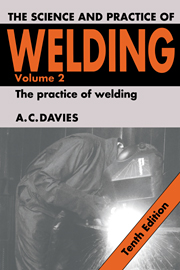Book contents
- Frontmatter
- Contents
- Preface
- 1 Manual metal arc welding
- 2 Gas shielded metal arc welding
- 3 Tungsten electrode, inert gas shielded welding processes (TIG), and the plasma arc process
- 4 Resistance welding and flash butt welding
- 5 Additional processes of welding
- 6 Oxy-acetylene welding
- 7 Cutting processes
- 8 The welding of plastics
- Appendixes
- 1 Welding symbols: British, American
- 2 Simplified notes on the operation of a thyristor
- 3 Proprietary gases and mixtures
- 4 Tests for wear-resistant surfaces
- 5 Conversion factors
- 6 Low hydrogen electrode, downhill pipe welding
- 7 The manufacture of extruded MMA electrodes
- 8 Notes on fire extinguishing
- 9 Table of brazing alloys and fluxes
- 10 Latest plant and equipment
- 11 Refraction and reflection
- 12 Notes on the welding of Duplex and Super Duplex stainless steels
- 13 Welding fumes: health and safety
- 14 Lasers and laser welding
- City and Guilds of London Institute examination questions
- Index
7 - The manufacture of extruded MMA electrodes
Published online by Cambridge University Press: 11 May 2010
- Frontmatter
- Contents
- Preface
- 1 Manual metal arc welding
- 2 Gas shielded metal arc welding
- 3 Tungsten electrode, inert gas shielded welding processes (TIG), and the plasma arc process
- 4 Resistance welding and flash butt welding
- 5 Additional processes of welding
- 6 Oxy-acetylene welding
- 7 Cutting processes
- 8 The welding of plastics
- Appendixes
- 1 Welding symbols: British, American
- 2 Simplified notes on the operation of a thyristor
- 3 Proprietary gases and mixtures
- 4 Tests for wear-resistant surfaces
- 5 Conversion factors
- 6 Low hydrogen electrode, downhill pipe welding
- 7 The manufacture of extruded MMA electrodes
- 8 Notes on fire extinguishing
- 9 Table of brazing alloys and fluxes
- 10 Latest plant and equipment
- 11 Refraction and reflection
- 12 Notes on the welding of Duplex and Super Duplex stainless steels
- 13 Welding fumes: health and safety
- 14 Lasers and laser welding
- City and Guilds of London Institute examination questions
- Index
Summary
As previously stated, almost all electrodes are produced by the extrusion process. The present day electrode consists of a core wire, centrally placed in a coating, usually silicate bonded (Vol. 1, p. 60). Double coated electrodes are also produced.
A semi-automatic production line may consist of the following:
Wire drawing. Non-slip hydraulic machines draw the wire through dies to the correct size, after which the wire is stored on reels.
Wire cutting. The wire is then straightened and cut to electrode length, giving burr-free wire rods of any required length which are stacked in bins.
The coating. The raw materials of the coatings are kept in raw material silos and from these the materials are sieved and dosed. It is the type and composition of these materials that determines the characteristic of the particular electrode. The dosing installations consist of a number of silos each fitted with a discharge system, dosing control and weighing facilities.
Silicate storing consists of tanks that are temperature controlled and from which the silicate is pumped to the mixer.
Dry blending and wet mixing. The batch is first thoroughly mixed in the dry state and then a measured quantity of silicate is added from a dosing unit. The wetted batch is then roughly mixed, emptied and removed to the slug press, where it is pressed into slugs ready for extrusion.
[…]
- Type
- Chapter
- Information
- The Science and Practice of Welding , pp. 409 - 411Publisher: Cambridge University PressPrint publication year: 1993

